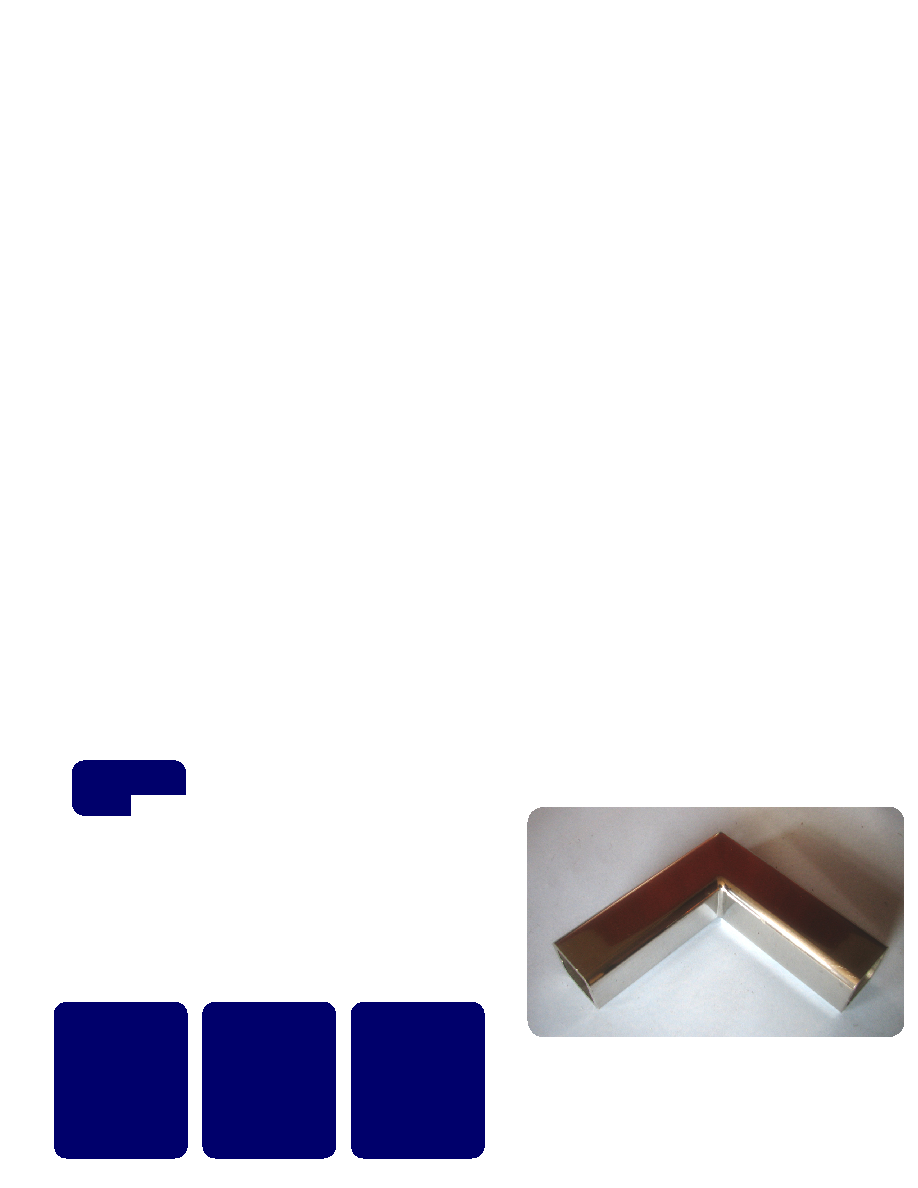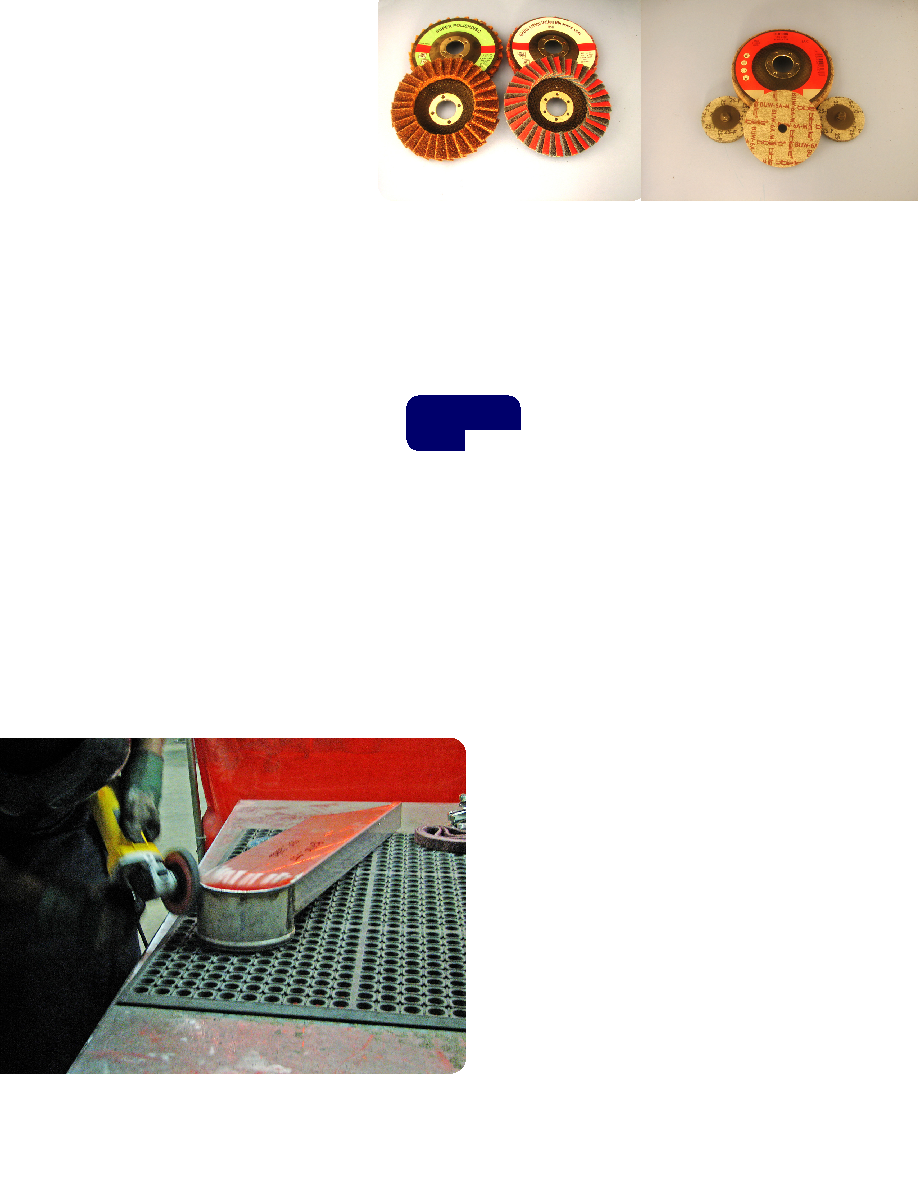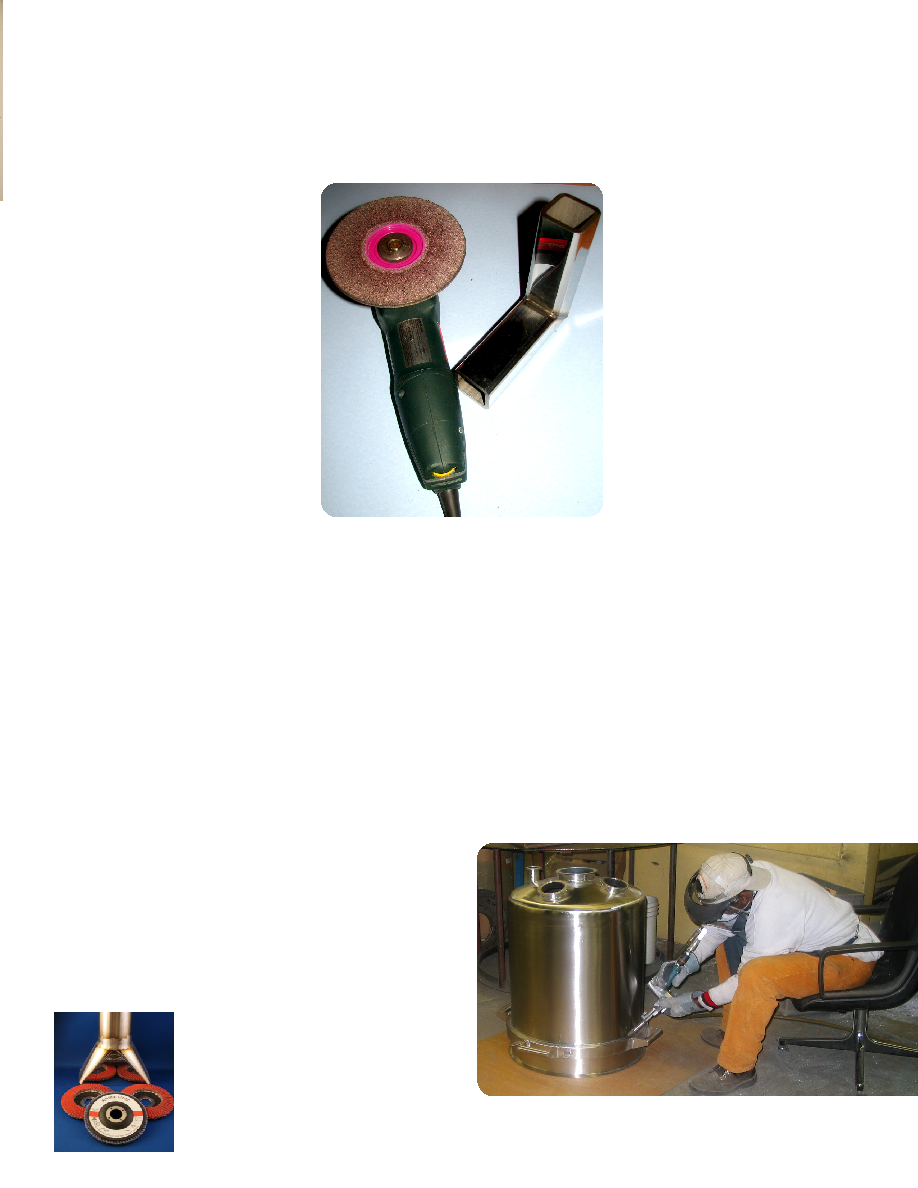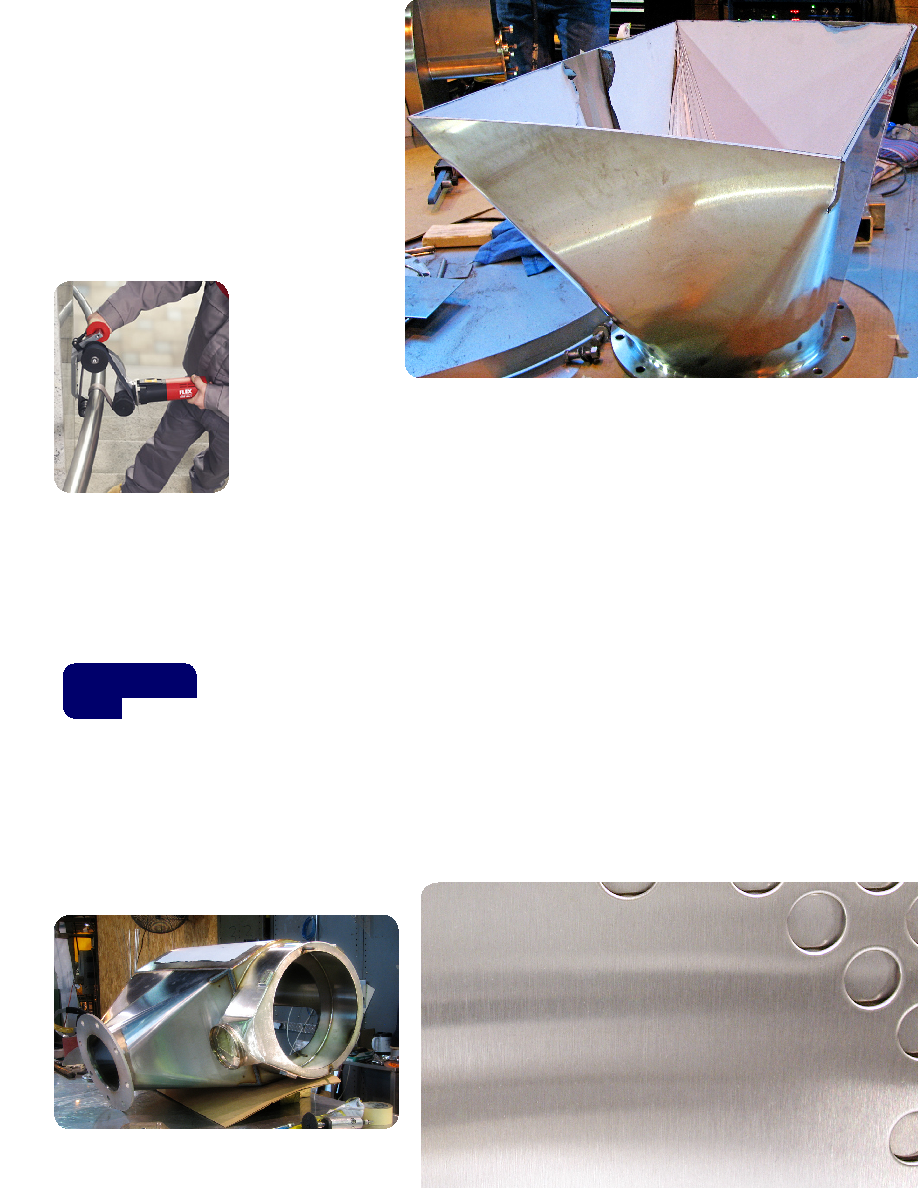
In North America,
the use of stainless steel continues to grow in
popularity both inside and outside the home due to its many advantages.
Architects, engineers and contractors increasingly specify stainless steel
for use in construction, appliances, food processing equipment and the
medical field. As stainless steel usage continues to grow, proficiency in
finishing will take on increased importance.
For fabricators, the ability to proficiently fabricate and finish stainless
steel, can lead to both increased business and profitability. The most
effective fabricators follow a three step process for stainless steel finishing
projects. The first step involves working with the customer in order to
define and document the finish required for the project. Next the fab-
ricator must choose the correct abrasives and power tools that will be
used on the job to achieve the required finish. And finally, the fabricators
must create and execute the mechanical finishing process plan in order
to complete the project and satisfy the customer.
The first step
for fabricators
is to work with
each customer
to define the finish required. The finish for the base material and treat-
ment of the welds should be discussed and agreed upon. Generally, the
material finish is specified in grit (the particle size for the last step in
the abrasive finishing process). Stainless steel mate-
rial specifications are defined below.
Mechanical Finish Designations for
Steel Materials
#2D Finish
- a uniform, dull silver gray
mill finish that is applied to thinner stain-
less steel coils, the thickness of which has
been reduced by cold rolling.
#2B Finish
- A bright cold rolled mill
finish commonly produced in the same
manner as No. 2D, except that the final
light cold rolling pass is done using pol-
ished rolls.
#3 Finish
- A semi-polished surface
achieved by finishing with the equiva-
lent of a 80 to 120-grit abrasive. This
finish has a pronounced grit line.
·
·
·
Finish That Stainless Steel!
Once you reach agreement with a client on
a finish, it's important that you choose the
right materials, tools, and use the correct
technique for the finish type selected.
BY CHRIS STONE
step one
DEFINE THE FINISH
A sample swatch can be made out of tubing.
This sample shows a #7 finish, with welds
ground flus and pit and crevice free (similar
to NOMMA #1 finish).
Three steps to finishing
stainless steel:
Define
the finish
Choose
the right
abrasive
and power
tools
Finalize &
execute
the plan

#4 Finish
- Also called brushed, di-
rectional or satin finish A number 4
finish, characterized by fine polish-
ing grit lines that are uniform and
directional in appearance. The final
abrasive used in the process is 150 to
220 grit.
#6 Finish
- Polished finish achieved
with the equivalent of a 240-grit
abrasive. Finer grit lines and higher
reflectivity than n No. 4 finish.
#7 Finish
- Highly reflective sur-
face obtained with the equivalent
of a 320-grit abrasive. Minimal grit
lines.
#8 Finish
or Mirror Finish - pro-
duced by polishing with at least a
320 grit belt or wheel finish. The
part is then sisal and color buffed to
achieve a mirror-like finish.
Weld Treatment
The treatment of the welds should also be de-
fined with the customer. Weld treatment op-
tions are as follows;
Remove weld spatter and discoloration
only.
Remove weld spatter, discoloration and
weld ripple.
Remove weld spatter, discoloration and weld
ripple, plus grind weld smooth with base ma-
terial.
Remove weld spatter, discoloration and weld
ripple, plus grind weld smooth with base
material, and producing all welds pit and
crevice free.
·
·
·
·
1.
2.
3.
4.
Once the customer and fabricator have defined the material finish and weld
treatment, a sample swatch can be created to use as reference. The sample
swatch can be as simple as two pieces of stainless steel square tubing welded
together and finished per the aforementioned specifications.
Choosing Abrasives
Discs and belts are the most
popular abrasive mediums
for mechanical finishing of
stainless steel. Most often
abrasive discs are used for weld treatment, and belts are used for material
surface treatment. The one notable exception is the use of Dynafile small
portable belts for treating welds in hard to reach locations.
The following illustrates the typical mechanical finishing steps for weld
treatments along with the appropriate abrasive.
For removal of excess weld, spatter and discoloration, use the fol-
lowing abrasives:
For creating a uniform scratch pattern in weld, use
the following abrasives:
The advent of the flap disc has significantly reduced the steps
required for stainless steel finishing. In the past, operators
used a two step process for weld treatment consisting of a
grinding wheel for the first step (material removal) and then
resin fiber discfor the second step (uniform scratch pat-
tern).
Increasingly, the flap disc is replacing the older two-step
process with a single step, requiring only one abrasive prod-
uct. Layers of coated abrasive are arranged on a backing pad
in a fan like arrangement. In addition to reduced processing
times, flap discs are less prone to gouging and scratching the
work piece (very common with grinding wheels). Gouging
and scratching can significantly increase downstream polish-
ing times.
·
·
·
·
·
·
·
·
step two
CHOOSING ABRASIVES
AND POWER TOOLS
The sets of discs shown above in-
(LEFT)
,
(RIGHT)
.
Unitized discs
(PHOTO ABOVE)
.
An employee is using a unitized disc to create a
#4 finish. Notice the operator's use of a protec-
tive rubber to prevent the material from scratching
during polishing.

For finer weld finishing, a bevy of new
products are now available that improve
surface finishes and reduce polishing
times. The newer products include sur-
face conditioning flap discs, combina-
tion flap discs, and unitized disc. Surface
conditioning material is a nylon web
impregnated with abrasive grit. The ma-
terial is available in coarse (50-80 grit),
medium (100-150 grit), fine (180-220
grit), and very fine (240 -360grit) and
produces a matte like finish when ap-
plied to stainless steel. Combination
discs combine coated abrasive and sur-
face conditioning on the same backing
pad in an interleaf pattern, thus remov-
ing the weld and polishing at the same
time. Unitized discs consist of layers of
non-woven material impregnated with
abrasive grit. They are available in coarse
through fine grits and excel at producing
fine finishes on stainless steel welds.
Abrasive Belts
As previously discussed, belts are gener-
ally used to process larger material sur-
face areas. The two main categories of
abrasive belts used in stainless steel fin-
ishing are coated and surface condition-
ing.
Traditionally, zirconia-coated abrasives
belts were used for stainless steel fin-
ishing. However, the introduction of
newer ceramic grain belts caused a rise
in popularity of stainless steel finishing.
The newer ceramics offered by leading
coated abrasive manufacturers, such as
VSM Abrasives and Norton Abrasives,
require less pressure, last longer than
other coated abrasives, and cut cooler--
particularly important for stainless steel
finishing as heat generation is an obstacle
to effective finishing.
Belts made out of surface conditioning
are generally applied after the coated
abrasives do their work. The surface
conditioning belts texture more than
remove material. The belts generate the
appearance of a linear brushed finish on
the material.
When sequencing abrasives, fabricators
should work from coarse to fine. Skip-
ping more than one grade level when
moving finer in grit tends to give the
material an uneven choppy look. When
blending welds and
large surfaces, using
longer strokes will
result in a more even
appearance.
Power Tools
While the angle
grinder is still the
workhorse for stain-
less steel weld fin-
ishing, linear belt
finishing tools are re-
quired to achieve the
higher level stainless
steel finishes that are
more frequently be-
ing specified.
Power tools are available as pneumatic
or electric. Pneumatic tools offer the ad-
vantage of being lighter, and therefore,
easier for the operator to hold and han-
dle. On the other hand, electric power
tools offer the advantage of more power
and variable speed control.
The ability to control the speed of the
tool is essential for stainless steel finish-
ing. As the surface finish becomes finer,
the speed of the tool must be reduced
to achieve a uniform appearance in the
surface finish. Therefore, fabricators at-
tempting #4 finishes and finer, need to
have variable speed angle grinders and
linear belt finishers in their workshops.
By reducing finishing speeds as the sur-
face finish becomes finer, abrasive con-
sumption is also reduced resulting in the
need for fewer abrasives to complete the
project.
New grinders, such as the WE14-125VS
from Metabo, offer variable speed, vi-
bration reduction, quick wheel change
and a powerful 12 amp motor. The
yellow dial at the bottom controls the
speed. This 6" unitized disc must be run
at 3000 rpm (a normal grinder runs at
11000 rpm) and will grind and polish the
corner weld in a single step.
For linear finishing and blending welds
with adjacent pre-polished material,
When sequencing abrasives, fabricators
should work from coarse to fine.
speed vibration reduction.
used to remove
the weld in a
p r e - p o l i s h e d
stainless
steel
square to round
transition.
The Dynafile is ideal for hard-to-reach areas. They
are ideal for areas that can't be reached by a grinder
or polisher.

variable speed burnishing machines such as the
flex machine below, allow operators to more eas-
ily achieve desired finishes in stainless steel. It is
important to note that a linear scratch pattern
(frequently specified for stainless steel finishes)
cannot be achieved with an angle grinder. The
angle grinder will leave swirl marks in the mate-
rial. Only a burnisher, like the unit below, can
achieve the desired finish.
A relatively new class of power tool has been gain-
ing popularity for polishing pipe and hand rails.
The pipe sander
wraps 270 degrees
around the work
piece and quickly
accomleft: plishes
finishing
tasks
with ease. The
p r e - t e n s io n e d
arms apply even
pressure to the
workpiece pro-
ducing a uniform
finish.
The Dynafile is
another tool re-
quired for most
stainless steel finishing jobs. The tool accepts small
portable belts and excels at accessing hard to reach
areas. Dynafiles are typically used where access to
use the grinder or polisher cannot be gained.
The final step is to create the mechanical stain-
less steel finishing plan and execute completion
of the project. This involves pre-planning the
actual work steps involved in order to complete
the required finish. Each work step should list the
power tool, abrasive type and grit which will be
used.
Nowhere is preparing more important than in the area of mechanical pol-
ishing. By carefully planning the project, hours of needless re-work can be
avoided. If fabricators are attempting a finish they have not achieved in the
past, they may want to consult with their abrasives and power tool distributor
for guidance.
The following points should be considered during the planning process:
Ordering pre-polished material when possible.
Protecting the material with a plastic film coating.
When possible using TIG welding.
Minimize weld diameter and spatter.
Pre-polishing parts that have difficult access points.
Educate employees concerning care in material handling (stainless steel is
easily scratched).
Part in Finishing Process
In summary, the three steps critical to successful stainless steel finishing include
defining the customers, requirements, planning the sequence, which includes
choosing the abrasives and tools that will be used, and executing the plan. By
adopting this approach, fabricators can fulfill their customers' requirements in
the least time and with the least cost.
1.
2.
3.
4.
5.
6.
270 degrees around the
work piece.
step three
FINALIZE AND
EXECUTE THE PLAN
The inside of this part is pre-polished and protected with
platic film during the manufacturing process. The film is
peeled back at the welded seams.
Part in finishing process.
About the Author:
This article was printed in the September/October 2009
issue of Fabricator magazine.
For more information:



